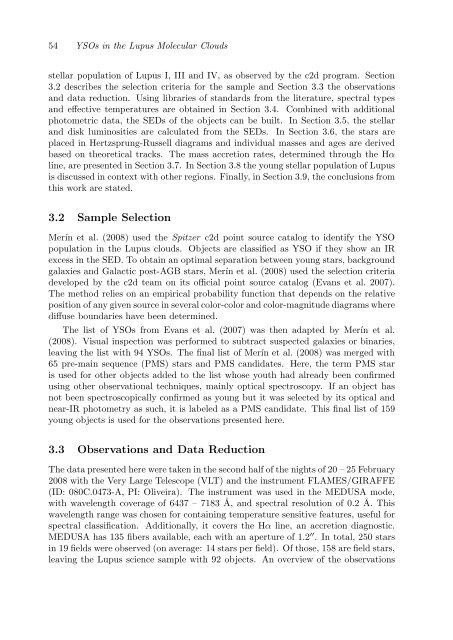Observational Constraints on The Evolution of Dust in ...
Observational Constraints on The Evolution of Dust in ...
Observational Constraints on The Evolution of Dust in ...
You also want an ePaper? Increase the reach of your titles
YUMPU automatically turns print PDFs into web optimized ePapers that Google loves.
54 YSOs <strong>in</strong> the Lupus Molecular Clouds<br />
stellar populati<strong>on</strong> <strong>of</strong> Lupus I, III and IV, as observed by the c2d program. Secti<strong>on</strong><br />
3.2 describes the selecti<strong>on</strong> criteria for the sample and Secti<strong>on</strong> 3.3 the observati<strong>on</strong>s<br />
and data reducti<strong>on</strong>. Us<strong>in</strong>g libraries <strong>of</strong> standards from the literature, spectral types<br />
and effective temperatures are obta<strong>in</strong>ed <strong>in</strong> Secti<strong>on</strong> 3.4. Comb<strong>in</strong>ed with additi<strong>on</strong>al<br />
photometric data, the SEDs <strong>of</strong> the objects can be built. In Secti<strong>on</strong> 3.5, the stellar<br />
and disk lum<strong>in</strong>osities are calculated from the SEDs. In Secti<strong>on</strong> 3.6, the stars are<br />
placed <strong>in</strong> Hertzsprung-Russell diagrams and <strong>in</strong>dividual masses and ages are derived<br />
based <strong>on</strong> theoretical tracks. <strong>The</strong> mass accreti<strong>on</strong> rates, determ<strong>in</strong>ed through the Hα<br />
l<strong>in</strong>e, are presented <strong>in</strong> Secti<strong>on</strong> 3.7. In Secti<strong>on</strong> 3.8 the young stellar populati<strong>on</strong> <strong>of</strong> Lupus<br />
is discussed <strong>in</strong> c<strong>on</strong>text with other regi<strong>on</strong>s. F<strong>in</strong>ally, <strong>in</strong> Secti<strong>on</strong> 3.9, the c<strong>on</strong>clusi<strong>on</strong>s from<br />
this work are stated.<br />
3.2 Sample Selecti<strong>on</strong><br />
Merín et al. (2008) used the Spitzer c2d po<strong>in</strong>t source catalog to identify the YSO<br />
populati<strong>on</strong> <strong>in</strong> the Lupus clouds. Objects are classified as YSO if they show an IR<br />
excess <strong>in</strong> the SED. To obta<strong>in</strong> an optimal separati<strong>on</strong> between young stars, background<br />
galaxies and Galactic post-AGB stars, Merín et al. (2008) used the selecti<strong>on</strong> criteria<br />
developed by the c2d team <strong>on</strong> its <strong>of</strong>ficial po<strong>in</strong>t source catalog (Evans et al. 2007).<br />
<strong>The</strong> method relies <strong>on</strong> an empirical probability functi<strong>on</strong> that depends <strong>on</strong> the relative<br />
positi<strong>on</strong> <strong>of</strong> any given source <strong>in</strong> several color-color and color-magnitude diagrams where<br />
diffuse boundaries have been determ<strong>in</strong>ed.<br />
<strong>The</strong> list <strong>of</strong> YSOs from Evans et al. (2007) was then adapted by Merín et al.<br />
(2008). Visual <strong>in</strong>specti<strong>on</strong> was performed to subtract suspected galaxies or b<strong>in</strong>aries,<br />
leav<strong>in</strong>g the list with 94 YSOs. <strong>The</strong> f<strong>in</strong>al list <strong>of</strong> Merín et al. (2008) was merged with<br />
65 pre-ma<strong>in</strong> sequence (PMS) stars and PMS candidates. Here, the term PMS star<br />
is used for other objects added to the list whose youth had already been c<strong>on</strong>firmed<br />
us<strong>in</strong>g other observati<strong>on</strong>al techniques, ma<strong>in</strong>ly optical spectroscopy. If an object has<br />
not been spectroscopically c<strong>on</strong>firmed as young but it was selected by its optical and<br />
near-IR photometry as such, it is labeled as a PMS candidate. This f<strong>in</strong>al list <strong>of</strong> 159<br />
young objects is used for the observati<strong>on</strong>s presented here.<br />
3.3 Observati<strong>on</strong>s and Data Reducti<strong>on</strong><br />
<strong>The</strong> data presented here were taken <strong>in</strong> the sec<strong>on</strong>d half <strong>of</strong> the nights <strong>of</strong> 20 – 25 February<br />
2008 with the Very Large Telescope (VLT) and the <strong>in</strong>strument FLAMES/GIRAFFE<br />
(ID: 080C.0473-A, PI: Oliveira). <strong>The</strong> <strong>in</strong>strument was used <strong>in</strong> the MEDUSA mode,<br />
with wavelength coverage <strong>of</strong> 6437 – 7183 Å, and spectral resoluti<strong>on</strong> <strong>of</strong> 0.2 Å. This<br />
wavelength range was chosen for c<strong>on</strong>ta<strong>in</strong><strong>in</strong>g temperature sensitive features, useful for<br />
spectral classificati<strong>on</strong>. Additi<strong>on</strong>ally, it covers the Hα l<strong>in</strong>e, an accreti<strong>on</strong> diagnostic.<br />
MEDUSA has 135 fibers available, each with an aperture <strong>of</strong> 1.2 ′′ . In total, 250 stars<br />
<strong>in</strong> 19 fields were observed (<strong>on</strong> average: 14 stars per field). Of those, 158 are field stars,<br />
leav<strong>in</strong>g the Lupus science sample with 92 objects. An overview <strong>of</strong> the observati<strong>on</strong>s
















